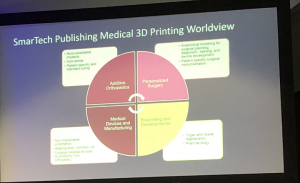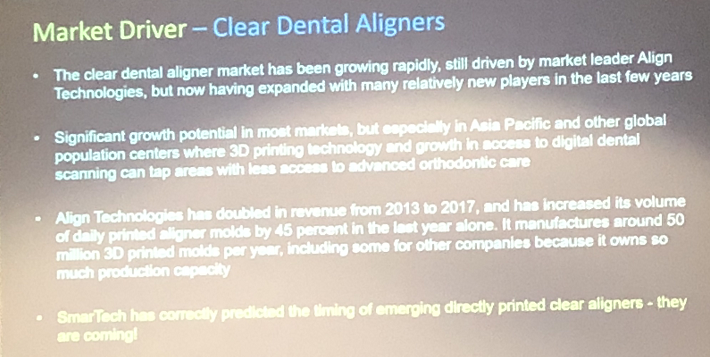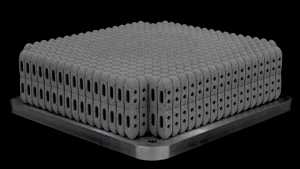Last week, our second annual Additive Manufacturing Strategies summit, “The Future of 3D Printing in Medicine and Dentistry,” was held in Boston. Co-hosted by SmarTech Markets Publishing, the summit was broken into separate tracks – one for medical and one for dental – and included a wide variety of speakers, a startup competition, and an exhibition floor.
Attendees were able to learn about a range of important and useful 3D printing topics, such as surgical planning and modeling, regulatory issues, implants, dental materials like ceramics, bioprinting, the use of AM in veterinary medicine, and international 3D printing developments in the medical and dental fields.
 After Tuesday’s keynote and a quick break for some coffee, I started off on the dental track attending a presentation on SmarTech’s dental 3D printing forecast. The talk was given by the company’s VP of Research Scott Dunham, whom Lawrence Gasman, the President of SmarTech, called “one of the top analysts in the country in our area.”
After Tuesday’s keynote and a quick break for some coffee, I started off on the dental track attending a presentation on SmarTech’s dental 3D printing forecast. The talk was given by the company’s VP of Research Scott Dunham, whom Lawrence Gasman, the President of SmarTech, called “one of the top analysts in the country in our area.”
Dunham explained that during the “strategy maturation period” for many 3D printing companies, dentistry has now become a very important “focal area,” as it’s managed to “infiltrate the clinical segment in an increasingly meaningful way.” Mainly due to a significant leveraging of dental labs, one of the largest opportunities in the 3D printing industry today is in the dental field.
According to Dunham, there will be three main drivers for dental 3D printing applications over the next five years:
- clear dental aligners
- full dentures
- temporary and permanent restorations in dental ceramics and composites
Dunham noted that SmarTech had correctly predicted the timing when it came to aligners, which will likely see its major challenges in terms of materials development. However, some companies, such as EnvisionTEC, have already created materials for making clear dental aligners, with the assistance of 3D printing.
FDA-approved 3D printable denture base materials, which have proper aesthetic properties, have actually been around for several years, but there was a major uptick in interest from the industry over the last year or so to bring denture-related applications to the AM market through material partnerships. In terms of permanent restorations in dental ceramics and composites, the use of micro-filled hybrid materials to make temporary dentures has been a sort of “jumping-off point” for making permanent restorations, like bridges, crowns, and implants.
According to Dunham, we’re likely to see much more “diversity in what’s driving dental hardware & materials in the future,” and the ratio of materials to hardware in dental 3D printing is an indicator that the industry is transforming. Dental 3D printing materials are mostly high value, especially the ones that can retain margins and cost on average per kilogram more than many other segments, and the value of the materials exceeds the value of hardware in the dental field more so than in other applications, which makes it unique.
 Once his presentation ended, I followed Dunham over to the next room, which was on the medical track, to hear his next presentation; this time he would be discussing SmarTech’s medical 3D printing forecast. One of the main reasons SmarTech co-hosts the AMS summit with us is because innovation in healthcare is part of the DNA of the 3D printing industry, and Dunham stated that the three main pillars of adopting 3D printing in the industry are prototyping, healthcare, and industrial manufacturing.
Once his presentation ended, I followed Dunham over to the next room, which was on the medical track, to hear his next presentation; this time he would be discussing SmarTech’s medical 3D printing forecast. One of the main reasons SmarTech co-hosts the AMS summit with us is because innovation in healthcare is part of the DNA of the 3D printing industry, and Dunham stated that the three main pillars of adopting 3D printing in the industry are prototyping, healthcare, and industrial manufacturing.
Dunham said that SmarTech believes there are “a number of reasons that healthcare applications will shift to become the backbone of the industry,” such as:
- low barrier to entry, though he did note the existing FDA regulatory hurdles
- high volume applications – device types, procedures, and treatments currently being commercially explored with 3D printing
- industry disruption through design – treatments tend to be more successful with with individualized, patient-specific devices
- the major societal impact it could have, moving beyond just 3D printing devices and models but expanding the universe of treating patients
Dunham provided a brief history of healthcare innovation in 3D printing, starting with SLA first being used for medical modeling in 1988, noting the first patented process for 3D printing hearing aid shells in 1999, the first recorded Ti-64 patient-specific 3D printed implant in 2007, the mainstreaming of patient-specific 3D printed knee instrumentation in 2010, and the launching of Materialise HeartPrint in 2013.
The outlook for medical 3D printing opportunities, including materials, services, software, and hardware, is currently estimated to be $1.25 billion, but the total is estimated to be $6.08 billion by the year 2027. If these totals are split into segments, Dunham said that the global revenue will likely be tied to three main areas: orthopedics, personalized surgery, and medical devices. Then he moved onto the recent strategic updates that influenced these estimates.
Dunham explained that there are many opportunities in the additive orthopedics sector, due to the fact that many of the large market players are stepping up their adoption of metal 3D printing in order to enhance traditional implant design for improved performance. He referenced a case study by Betatype centered around developing software solutions for orthopedic companies already involved in 3D printing, noting that “they achieved some really amazing results” in the study. When working to determine if 3D printing would become the main process in the future for making orthopedic implant devices, Dunham said that SmarTech figured the technology would most likely “at least tip the 50% penetration point.”In terms of medical device manufacturing, Dunham said SmarTech definitely believes there are production opportunities for 3D printing, especially since the estimated value of medical 3D printing services in 2027 is $1.5 billion. He noted that there are an increasing number of opportunities to use 3D printing when fabricating medical devices with customized elements that are matched to specific procedures or treatments; on the flip side, use is also increasing of a range of production-oriented 3D printing methods in order to produce parts for medical devices and equipment that already exist.
Some of the major takeaways Dunham noted at the end of his presentation were that societal impact, and improving patient outcomes, are both “perfectly valid” ways of measuring how 3D printing is disrupting the industry, rather than just relying on money alone.
Discuss this news and other 3D printing topics at 3DPrintBoard.com or share your thoughts below.
[Images: Sarah Saunders]Subscribe to Our Email Newsletter
Stay up-to-date on all the latest news from the 3D printing industry and receive information and offers from third party vendors.
Print Services
Upload your 3D Models and get them printed quickly and efficiently.
You May Also Like
Consolidation in AM: How 2025 Is Shaping the Industry’s New Normal
The first half of 2025 has been marked by a clear shift in the additive manufacturing (AM) industry. Companies are no longer just focused on developing new tech by themselves....
Etsy Design Rule Change Reduces Selection of 3D Printed Goods
Online marketplace Etsy has implemented a rule change requiring all 3D printed goods on the site to be original designs. The update to the site’s Creativity Standards states, ¨Items produced using...
U.S. Congress Calls Out 3D Printing in Proposal for Commercial Reserve Manufacturing Network
Last week, the U.S. House of Representatives’ Appropriations Committee moved the FY 2026 defense bill forward to the House floor. Included in the legislation is a $131 million proposal for...
Transforming From Tourist to Native: Duro CEO Michael Corr Explains Why the Company Rebuilt its PLM Software on AI
In these early innings of the AI boom, many market analysts have expressed concern that AI spend has gotten too far ahead of the technology’s proven ability to deliver significant...





































